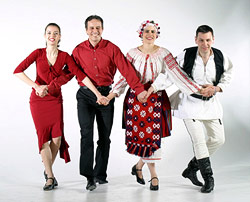When my mother moved to Seattle in the 1950s from Minneapolis, she was happy to leave her winter hats and gloves behind, but she joined the Skandia Folkdance Society so she could still do the Hambo and the Schottisch, souvenirs of her Scandinavian upbringing. In our polyglot culture today, where fusion is the style of the moment, we still look for those connections to older times and traditions. The Radost Folk Ensemble has been a bridge to the music and dance of the Balkans since its founding in 1976, and for their 30th anniversary this Saturday, March 25, they are doing one of the things they do best—throwing a party, and asking everyone to come.
There has always been a party atmosphere in Radost’s performances, which makes sense, since the dances are all inherently social. Originally, they came from the community or the village, and were performed at weddings, funerals, birthdays, and so on. Later on they were transferred to the theater, and the circle of friends was opened up to a formal audience. But the original intent was not to entertain a passive observer—it was to draw that person into the circle itself.
For Radost, that circle encompasses the folk art of the Balkans and, most ironically, the former Yugoslavia. When the company was founded, that part of the world was still unified by the top-down authority of the Tito administration; as those connections exploded into ethnic strife, the artists of Radost strove to keep politics out of the studio. The word “radost” means joy in several Slavic languages, and they’ve worked hard to keep that meaning intact.
At the anniversary party, the company will be joined by alumni and colleagues from other heritage groups: the Bokréta Hungarian Dance Ensemble; Dave and the Dalmatians; Orkestar RTW; the Dunava Women’s Choir; and the renowned Bulgarian vocalist Yordanka Ilieva.
Radost’s dances come from a social background, but that doesn’t mean they’re simple. The rhythms are complex—with time signatures like 9/8 and 13/16, the downbeats shifting everywhere, and lots of percussive hopping and jumping. The dances are often set up in a competitive structure, getting faster or harder with each repetition, and the members of the group depend on everyone to get it right or else. The French concept of the faux pas, or false step, comes from a different dancing tradition, but the idea is the same—make a mistake, and disaster results.
Many of the original members of Radost didn’t come from the same background as the dances they performed, and though there’s been a major influx of ethnic Bulgarians in the last few years, they didn’t necessarily arrive already knowing the steps. Urban and educated, they’re now learning the dances that their village grandparents might have done, and in that way, they are just like all of us, dancing a balance between the worlds that used to be and the ones we make today. If the old saying is true and we need to walk a mile in someone’s shoes to understand their situation, then perhaps we need to dance their dances as well, to get the whole picture.








